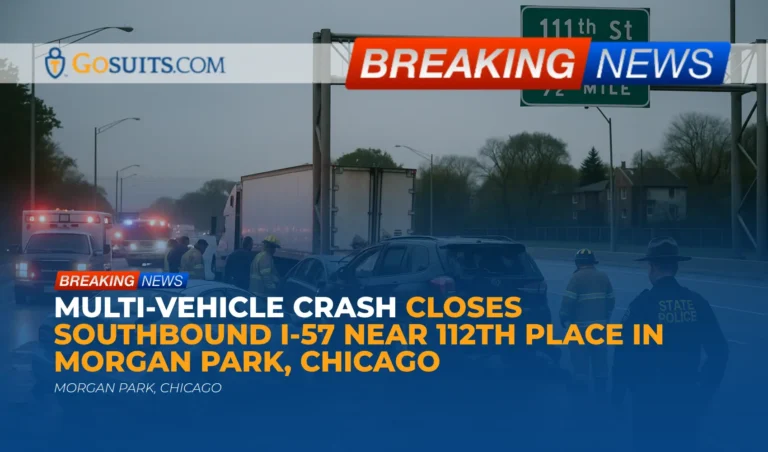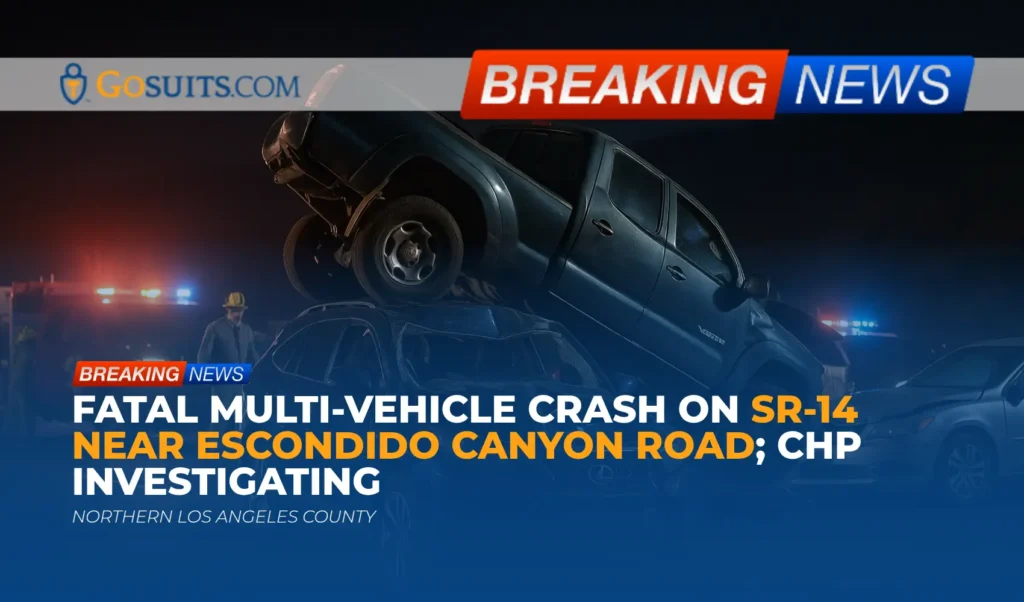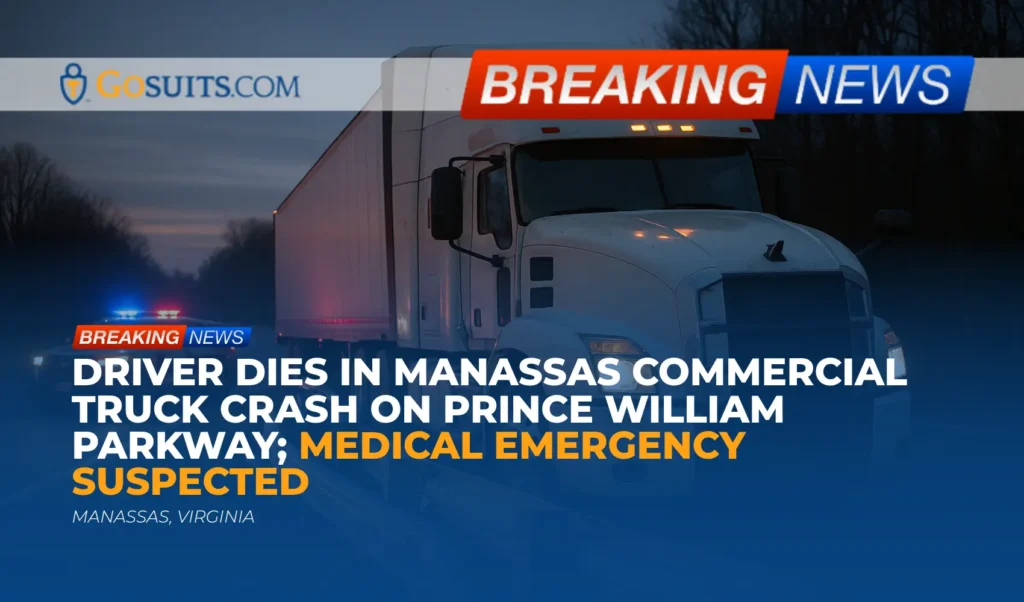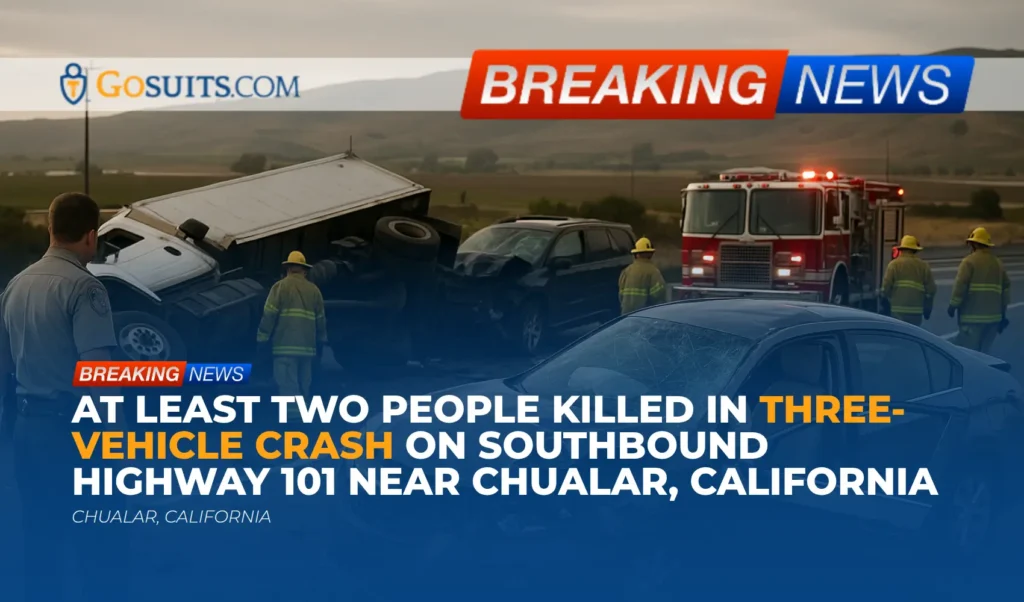- What we know about the I-57 multi-vehicle crash in Morgan Park
- Location context: I-57 at 112th Place and early-morning conditions
- Immediate steps people often take after a highway crash
- How to obtain official records and information
- Insurance and financial considerations after a serious crash
- Potential civil liability issues in multi-vehicle interstate crashes
- Understanding injuries and the importance of medical care
- Transportation disruptions and where updates typically come from
- Support if a fatality occurred and where to find help
- Why taking action early matters
- Commentary from Gosuits Chicago, Illinois Personal Injury Attorney
What we know about the I-57 multi-vehicle crash in Morgan Park
Early Sunday morning, around 4:45 a.m., a serious crash on Interstate 57 near 112th Place prompted the closure of all southbound lanes in the Morgan Park area of Chicago. Illinois State Police reported that multiple vehicles were involved and that there were injuries. Emergency crews were seen working at the scene. As of the time of reporting, authorities had not announced when lanes might reopen, and additional details about the number of people injured, the causes, or the sequence of events had not yet been released.
In incidents like this one, authorities typically secure the scene, provide medical aid, document vehicle positions and debris, photograph damage, and take witness statements. Interstate crashes are often investigated by the Illinois State Police, and traffic-management agencies may assist with detours and lane closures to protect responders and the public.
Location context: I-57 at 112th Place and early-morning conditions
I-57 is a major interstate corridor through Chicago’s South Side. The stretch near 112th Place in Morgan Park carries a mix of commuter and commercial traffic. Early-morning hours can present specific challenges: reduced light before sunrise, fewer visual cues, possible fatigue among drivers, and colder overnight temperatures that sometimes affect road surface conditions. While no cause has been identified publicly in this crash, it is common for investigators to consider factors such as speed relative to conditions, lane changes, following distance, and the ripple effects of sudden braking in a multi-vehicle chain reaction.
Because this incident involved multiple vehicles and lane closures, investigators may need extended time to safely reconstruct what happened. On interstates, even minor changes in traffic flow can increase the risk of secondary impacts, which is one reason authorities fully close lanes when necessary.
Immediate steps people often take after a highway crash
Highway crashes can be disorienting and frightening. While each situation is different, people involved in serious collisions often focus on the following safety and documentation steps once they are out of immediate danger.
- Prioritize medical care. Call 911, accept on-scene medical evaluation, and follow through with emergency care if recommended. Some serious injuries are not immediately obvious.
- Move to safety if possible. If vehicles are operable and it is safe, pulling to the shoulder can reduce the risk of a secondary collision. If not, remain inside the vehicle with seatbelts fastened until responders direct otherwise.
- Preserve evidence. When safe, photograph vehicle positions, damage, debris, the roadway, and any visible injuries. Take note of weather, lighting, and any nearby cameras (overhead traffic cameras, dash cams).
- Exchange information. Exchange insurance and contact details with other drivers. Note the license plates and descriptions of all involved vehicles.
- Identify witnesses. If any bystanders or other motorists saw the crash, politely ask for contact information.
- Be cautious with statements. Provide honest information to law enforcement, but avoid speculating on fault. Consider speaking with an attorney before giving a recorded statement to any insurance company.
How to obtain official records and information
In Illinois, several agencies may hold important records related to a crash. The following resources are commonly relevant after a serious interstate collision.
Illinois State Police crash reports
The investigating agency for interstate crashes in the Chicago area is often the Illinois State Police. Crash reports, once finalized, can typically be requested online.
- ISP Crash Reports: Request copies through the Illinois State Police portal: https://isp.illinois.gov/CrashReport. Availability depends on report completion and processing timelines.
- Supplemental materials: Photographs or reconstructions, if any, may require specific requests to the agency. Some materials are not released until investigations are complete.
Illinois Motorist Report (IDOT)
Illinois requires drivers to submit a written report to the Illinois Department of Transportation if a crash meets certain thresholds. The online Illinois Motorist Report portal provides instructions and filing capability.
- Illinois Motorist Report: Access the reporting portal at https://apps.dot.illinois.gov/ilmr/. The state provides guidance on when a report is required and how to submit it.
Autopsy and death investigation records (if a fatality occurred)
In the tragic event that a crash results in a death, the Cook County Medical Examiner conducts the death investigation for incidents occurring in Chicago. Families can obtain information about reports through the office’s website.
- Cook County Medical Examiner: Information about autopsy reports, timelines, and procedures is available at https://www.cookcountyil.gov/agency/medical-examiner.
Freedom of Information Act (FOIA) requests for records
People sometimes pursue additional materials such as dispatch logs, 911 audio, or certain agency communications. FOIA requests must follow the applicable agency’s procedures, and exemptions may apply.
- Illinois FOIA overview: General guidance on submitting FOIA requests to Illinois state agencies can be found at https://www2.illinois.gov/foia/Pages/default.aspx.
- Cook County FOIA: For county-held records, see https://www.cookcountyil.gov/service/freedom-information-foia.
Note that some records, such as active investigative files or materials containing personal information, may be restricted or redacted.
Towing and vehicle location
After interstate crashes in Chicago, disabled vehicles may be removed by contracted towing providers at the direction of law enforcement to clear lanes quickly. The investigating agency or the roadside tow provider usually has information on where a vehicle was taken. People often start by contacting the Illinois State Police district or the non-emergency line noted on the crash report to identify the storage facility and next steps for release and property retrieval.
Insurance and financial considerations after a serious crash
Insurance interactions after a multi-vehicle highway crash can be complex. Multiple insurers, questions about who initiated the chain of events, and disputes about comparative fault all affect how claims move forward.

Contact an attorney before speaking with insurance adjusters
Insurance companies routinely request recorded statements shortly after a crash. What someone says to an insurer can be used later to limit or deny claims. Speaking with a qualified attorney prior to giving a recorded statement can help protect legal rights and ensure accurate, complete information is provided at the right time.
Medical care and coverage
- Health insurance: Health plans generally cover emergency treatment, subject to deductibles and copays.
- Medical payments (MedPay): Some auto policies include MedPay, which can help with immediate medical expenses regardless of fault. Coverage amounts vary by policy.
- Liability coverage: The at-fault driver’s bodily injury liability coverage may apply to injury claims of others, subject to policy limits.
- Uninsured/underinsured motorist (UM/UIM): Illinois law requires UM coverage for bodily injury at certain minimum limits, and UIM coverage is often included when UM is purchased. See the Illinois Department of Insurance for general consumer guidance: https://insurance.illinois.gov/.
Property damage
- Collision coverage: If carried, this can facilitate quicker vehicle repairs or total-loss settlements while fault is being investigated.
- Diminished value: Some claims seek compensation for reduced resale value after repairs; eligibility varies and often requires documentation.
Preserving your claim
- Document everything: Keep medical records, bills, receipts, and any correspondence with insurers or repair facilities.
- Follow medical advice: Attend follow-up appointments and therapy; gaps in care can undermine injury claims and slow recovery.
- Be careful on social media: Posts can be misconstrued and used to contest injury severity.
Potential civil liability issues in multi-vehicle interstate crashes
Determining liability in a multi-vehicle collision can be complicated. Investigators and civil attorneys commonly analyze these elements.
- Negligence and duty of care: Every driver has a duty to operate reasonably under the circumstances. Factors include speed relative to traffic and conditions, following distance, lane changes, signaling, and attentiveness.
- Comparative fault in Illinois: Illinois follows a modified comparative fault rule. In general terms, a claimant’s recovery can be reduced by their percentage of fault, and recovery is barred if they are more than 50 percent at fault. See 735 ILCS 5/2-1116 at the Illinois General Assembly website: https://www.ilga.gov/legislation/ilcs/fulltext.asp?DocName=073500050K2-1116.
- Evidence sources: Police diagrams, event data recorders (black boxes), dash-cam videos, commercial-vehicle electronic logs, physical damage patterns, skid marks, and witness statements are often important. Prompt preservation requests can be crucial.
- Roadway or vehicle factors: While driver behavior is central in many crashes, investigators may examine whether vehicle defects or roadway conditions contributed. Specialized analysis may be required to evaluate these issues, and government-entity claims often involve strict timelines and procedures.
- Statutes of limitations: Illinois law imposes filing deadlines. As a general reference, personal injury actions commonly have a two-year limitation period (see 735 ILCS 5/13-202: https://www.ilga.gov/legislation/ilcs/fulltext.asp?DocName=073500050K13-202), and wrongful death actions also often carry a two-year period (see 740 ILCS 180/2: https://www.ilga.gov/legislation/ilcs/fulltext.asp?DocName=074000180K2). Certain exceptions and special procedures may apply, particularly with public entities.
Understanding injuries and the importance of medical care
Highway crashes can generate high forces even at moderate speeds, and injuries are not always immediately visible. People often experience symptoms hours or days later as adrenaline subsides. Common injuries include concussions, soft tissue injuries, fractures, internal injuries, and psychological trauma.
For head injuries, it is especially important to monitor for symptoms such as headache, dizziness, confusion, memory problems, sensitivity to light, or nausea. The Centers for Disease Control and Prevention provides general education on traumatic brain injury and concussion at https://www.cdc.gov/traumaticbraininjury/.
Documenting symptoms, following through with medical referrals, and obtaining recommended imaging or specialist evaluations help both with recovery and with establishing an accurate record of injury-related care.
Transportation disruptions and where updates typically come from
Major interstate closures in Chicago often require coordinated responses. Updates about closures and re-openings typically come from the Illinois State Police and the Illinois Department of Transportation. Media traffic desks and official agency channels share alerts about detours and expected timelines for lane re-openings. During extended closures, responders prioritize safe scene management, evidence preservation, and protection of motorists and emergency personnel.
Support if a fatality occurred and where to find help
Serious crashes can have devastating consequences. If a loved one dies in a collision, the path forward is emotionally and practically difficult. In Cook County, the Medical Examiner’s Office is the point of contact for death investigations, identification, and release of remains. The office can provide information about death certificates and how to request autopsy reports. See the office’s page at https://www.cookcountyil.gov/agency/medical-examiner.
Families often gather several documents over time, including the autopsy report, death certificate, crash report, and any available photographs or diagrams. These materials can help answer questions and, if desired, support civil claims related to the incident.

Why taking action early matters
After a serious highway crash, time matters for practical, medical, and legal reasons. The steps below explain what many people choose to do and why early action can make a difference.
- Seek prompt medical evaluation. Early diagnosis improves treatment planning and recovery. It also creates a clear, contemporaneous record of injuries linked to the crash.
- Preserve evidence quickly. Skid marks fade, debris is cleared, and vehicles are repaired or salvaged. Early photographs, requests to preserve vehicle data, and identification of witnesses protect crucial information.
- Request official records. Police crash reports, 911 records, and medical examiner documentation can take time to process. Starting early reduces delays later.
- Consult a qualified attorney before insurers call. Insurance adjusters may seek recorded statements that shape how a claim is evaluated. Guidance before speaking with insurers helps avoid misunderstandings and protects rights.
- Understand deadlines. Statute-of-limitations periods and special notice requirements, particularly for public-entity claims, can be strict. Early evaluation helps ensure timelines are met.
- Coordinate vehicle and property issues. Quickly locating the vehicle, addressing storage fees, and arranging inspections can reduce out-of-pocket costs and preserve physical evidence.
Commentary from Gosuits Chicago, Illinois Personal Injury Attorney
Our hearts are with everyone affected by the multi-vehicle crash that closed southbound I-57 near 112th Place in Morgan Park. Incidents like this are frightening and disruptive, and for those injured or awaiting news about loved ones, the uncertainty is overwhelming. This article is intended for educational and general informational purposes to help the community understand the process that tends to follow a serious highway collision.
Based on the limited information available, this appears to be a significant multi-vehicle event requiring full-lane closures for safety and investigation. In these complex chain-reaction scenarios, liability assessments often turn on careful analysis of vehicle spacing, speed relative to conditions, response to hazards, and the sequence of impacts. Thorough investigations typically examine event data recorders, photographs, roadway evidence, and witness accounts to piece together what happened.
Insurance companies and large corporations routinely move quickly after serious crashes. Adjusters may contact people for recorded statements before they have had a chance to gather their bearings or review the official report. Early statements can be taken out of context or used to narrow the scope of coverage. Some carriers may also direct people to preferred repair facilities or suggest quick settlements before the full extent of injuries is understood. These practices can put crash victims at a disadvantage simply because they are unfamiliar with the process and focused on immediate medical needs.
A free consultation with a seasoned personal injury attorney can help people understand their rights, identify the records they may need, and avoid common pitfalls in early communications with insurers. It does not obligate anyone to move forward, but it provides clarity during a stressful time and can help ensure important deadlines and evidence preservation needs are not overlooked.
Sources and public information portals
- Illinois State Police Crash Report portal
- Illinois Department of Transportation – Illinois Motorist Report portal
- Cook County Medical Examiner
- Illinois Freedom of Information Act overview
- Cook County FOIA portal
- Illinois comparative negligence statute (735 ILCS 5/2-1116)
- Illinois statute of limitations for personal injury (735 ILCS 5/13-202)
- Illinois Wrongful Death Act – limitation period (740 ILCS 180/2)
- Illinois Department of Insurance – consumer resources
- CDC – Traumatic Brain Injury information






